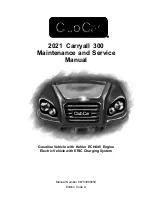
15
Battery Care
BATTERIES: ELECTRIC VEHICLE WITH
POWERDRIVE CHARGER
If a valve fails to open, the cell will eventually dry out. The initial one-time inspection of all cells
will identify any occurrence of a valve that fails to open. If a valve fails to close, it will become evident due to
the cell overflowing during routine watering. Either failure scenario is rare, but should be monitored in the initial
inspection and during routine watering sessions. Replace malfunctioning valves to ensure maximum battery
life.
See following CAUTION.
CAUTION
• After checking the electrolyte, fully tighten the battery caps to prevent electrolyte leakage.
2.
After the initial six-week inspection, manually check the electrolyte level at least once per year, particularly after
long-term storage or any other period of vehicle inactivity.
See preceding CAUTION.
BATTERY CARE – VEHICLES WITHOUT THE SINGLE-POINT WATERING SYSTEM
To keep batteries in good working condition, follow this maintenance program on a regular basis:
1.
Keep the batteries clean and free of corrosion. Wash tops and terminals of batteries with a solution of baking
soda and water (1 cup (237 mL) baking soda per 1 gallon (3.8 L) of water). Rinse solution off of the batteries. Do
not allow this solution to enter the battery. Be sure terminals are tight. Let the terminals dry and then coat with
Battery Terminal Protector Spray (CC P/N 1014305).
See following NOTE.
NOTE:
Dispose of waste water properly.
2.
Check the electrolyte level weekly
. Add water only
after
charging unless the electrolyte level is
below the top of the plates. In this case, add just enough water to cover the plates, charge, and then check the
level again. Never charge batteries if plates are exposed above electrolyte level. For best battery life, add only
distilled water.
See following CAUTION and NOTE.
CAUTION
• Do not overfill the batteries.
NOTE:
A battery watering gun or bottle is available at many auto parts dealers.
3.
The battery hold-downs should be tight enough so that the batteries do not move while the vehicle is in motion,
but not so tight as to crack or buckle the battery case. For 8-volt batteries, tighten hold-down retaining nuts to
106 in·lb (12 N·m). The terminal connections should be clean and tight, and any worn insulation or frayed wires
should be replaced. Tighten battery terminals to proper torque.
See Connecting the Batteries – Electric
Vehicles on page 1-4. See following WARNING.
WARNING
• If battery wire terminals are damaged or corroded, replace or clean them as necessary. Failure to
do so may cause them to overheat during operation and could result in fire, property damage, or
personal injury.
4.
After use, charge the batteries. The batteries should never be left discharged any longer than absolutely
necessary (do not leave discharged overnight).
Page 15-12
2014 Precedent
®
Golf Car Maintenance and Service Manual
Summary of Contents for Precedent 2014
Page 2: ......
Page 4: ......
Page 24: ......
Page 28: ......
Page 38: ......
Page 66: ......
Page 104: ......
Page 116: ......
Page 152: ......
Page 234: ......
Page 252: ......
Page 264: ......
Page 298: ......
Page 332: ......
Page 394: ......
Page 412: ......
Page 438: ......
Page 444: ......
Page 508: ......
Page 534: ......
Page 543: ......
Page 544: ......
Page 545: ......
Page 547: ......
Page 548: ......










































